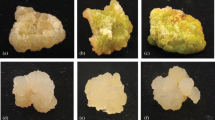Abstract
Phenolic compounds l,2,3-trihydroxy-5-methoxyxanthone, l-hydroxy-3,5,6,7, 8-pentamethoxyxanthone, and l,8-dihydroxy-2,3,4,6-tetramethoxyxanthone predominate in the callus tissue ofCentaurium erythraea, their content increasing with culture age. By contrast, the contents of the derivatives of cinnamic, chlorogenic, and ferulic acids decrease or do not change. In the cell suspension culture ofC. erythraea a larger amount of xanthones is synthesized than in the callus from which the suspension culture was derived. The content of phenolic acids is lower in the suspension culture than in the callus, but a larger number of low-molecular-mass phenolic substances occurs in the suspension culture than in the callus tissue.
Similar content being viewed by others
References
Aitohinson, P. A.,Mac Leod, A. J.,Yeoman, M. M.: Growth patterns in tissue (callus) cultures. - In: Stbeet, H. E. (ed.): Plant Tissue and Cell Culture. (Botanical Monographs. Vol. 11). Pp. 267–306. University of California Press, 1977.
Barešová, H.,Kamínkk, M.: Light induced somatic embryogenesis in suspension cultures ofCentaurium erythraea. - In: Novak, F. J., Havel, L., DoleŽel. J. (ed.): Plant Tissue and Cell Culture Application to Crop Improvement. (Proceedings of the International Symposium, Olomouc, Czechoslovakia). Pp. 163 –164, Praha 1984.
Brunet, G., Ibrahim, R. K.: Tissue culture of citrus peel and its potential for flavonoid synthesis. -Z. Pflanzenphysiol.69: 152–162, 1973.
Davies, M. E.: Polyphenol synthesis in cell suspension cultures of Paul’s Scarlet rose. - Planta104: 50–65, 1972.
Forrest, G. I.:Studies on the polyphenol metabolism of tissue cultures derived from the tea plant(Camellia sinensis L.).- Biochem. J.113: 765–772, 1969.
King, P. J.,Street, H. E.: Growth patterns in cell cultures. - In: Street, H. E. (ed.): Plant Tissue and Cell Culture. (Botanical Monographs. Vol. 11). Pp. 308–387. University of California Press, 1977.
Kurz, W. G. W.: Variation in indole alkaloid accumulation in cell suspension cultures fromGatharanthus roseus cultivars. - In: Prospects in Plant Cell Science and Technology. Pp. 11–20. Kyoto Symposia on Bioscience, 1984.
Lee, T. T., Carew, D. P., Rosazza, J.:Apocynum cannabinum tissue cultures: growth and chemical analysis. - Lloydia 35: 150–156, 1972.
Liau, S., Ibrahim, R. K.: Biochemical differentiation in flax tissue culture: phenolic compounds. -Can. J. Bot.31: 820–823, 1973.
Linsmaier, E. M., Skoog F.: Organic growth factor requirements of tobacco tissue cultures. - Physiol. Plant.18: 100–127, 1965.
Mabry, T. J., Markham, K. R., Thomas, M. B.: The Systematic Identification of Flavonoids. - Springer Verlag, New York 1970.
Meravý, L.: The effect of calcium deficiency on the content of phenolic compounds and auxins in wheat. - Acta Univ. Carolinae — Biol.1981: 379–396, 1985.
Miana, G. A., Al-Hazimi, H. M. G.: Xanthones ofCentaurium pulchellum. - Phytochemistry83: 1637–1638, 1984.
Neshta, N. M., Glyzin, V. I., Nikolaeva, G. G., Sheïchenko, V. I.: [The new xanthonic compound fromCentaurium erythraea.] In Russ. - Khim prirod. Soedin.19: 106–107, 1983b.
Neshta, N. M., Glyzin, V. I., Patudin, A. V.: [The new xanthonic compound fromCentaurium erythraea. IV.] In Russ. - Khim. prirod. Soedin.20: 110, 1984.
Neshta, N. M., Glyzin, V. I., Savina, A. A., Patudin, A. V.: [The new xanthonic compound fromCentaurium erythraea. III.] In Russ. - Khim. prirod. Soedin.19: 787, 1983a.
Neshta, N. M., Nikolaeva, G. G., Sheichenko, V. I., Patudin, A. V.: [The new xanthonic compound fromCentaurium erythraea.] In Russ. - Khim. prirod. Soedin.17: 258, 1982.
Parra, M., Picher, M. T., Seoane, E., Tortajada, A.: New xanthones isolated fromCentaurium linarifolium. - J. nat. Products (Lloydia)47: 123–126, 1984a.
Parra, M., Seoane, E., Tortajada, A.: Additional new xanthones isolated fromCentaurium linarifolium. - J. nat. Products (Lloydia)47: 868–871, 1984b.
Sahai, O. P., Shuler, M. L.: Environmental parameters influencing phenolic production by batch cultures ofNicotiana tabacum. - Biotechnol. Bioeng.26: 111–120, 1984.
Slabecka-Szweykowska, A.: On the condition of anthocyanin formation inVitis vinifera tissue cultivatedin vitro. - Acta Soc. Bot. Pol.21: 537–576, 1952.
Van der Suluis,W. G.: Sueeoiridoids and Xanthones in the GenusCentaurium Hill(Gentianaceae). -Drukkerij Elinkwijk bv., Utrecht 1985.
Van der Suluis,W. G., Labadie, R. P.: Polyoxygenated xanthones ofCentaurium littorale. -Phytochemistry 24: 2601–2605, 1965.
Takagi, S., Yamaki, M.: Studies on the constituents ofErythraea - Centaurium (Linné) Persoon. III. Isolation and structure of xanthones. - Yakugaku Zasshi102: 546–548, 1982.
Author information
Authors and Affiliations
Rights and permissions
About this article
Cite this article
Mebavý, L. Phenolic substances in tissue cultures ofCentaurium erythraea . Biol Plant 29, 81–87 (1987). https://doi.org/10.1007/BF02878153
Received:
Accepted:
Issue Date:
DOI: https://doi.org/10.1007/BF02878153




